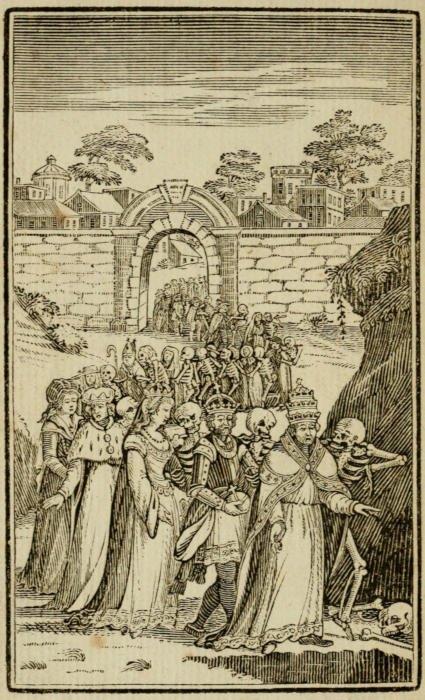Transcriber’s Note: Larger versions of illustrations are providedas linked images, for the detail of the engravings.
EMBLEMS
OF
MORTALITY;
REPRESENTING,
IN UPWARDS OF FIFTY CUTS,
DEATH
SEIZING ALL RANKS AND DEGREES
OF PEOPLE;
Imitated from a Painting in the Cemetery of theDominican Church at Basil, in Switzerland:
With an Apostrophe to each, translated from theLatin and French.
Intended as well for the Information of the Curious,as the Instruction and Entertainment of Youth.
TO WHICH IS PREFIXED
A copious Preface, containing an historical Accountof the above, and other Paintings on this Subject,now or lately existing in divers Parts of Europe.
LONDON:
Printed for T. Hodgson, in George’s-Court,
St. John’s-Lane, Clerkenwell.
M DCC LXXXIX.
The Work here presented to the Reader isa Copy, with a small Variation noticedhereafter, as to the Cuts, and a Translation, as tothe Letter Press, of one well known to the Curiousby the Title of Imagines Mortis, orThe Images of Death; which is reported to be inreality indebted for its Existence to an Event thatBoccace did but feign as the Occasion of writinghis Decameron; I mean the Calamity of aPlague: And its History is as follows.
Pope Eugenius IV. having summoned aCouncil to meet at the City of Basle, or, asit is more usually called, Basil, in Switzerland;it accordingly met there in the Year1431, and continued to sit for SeventeenYears, Nine Months, and Twenty-Seven Days,or, according to Mr. Walpole[1], but FifteenYears in the whole; and at this Council thePope himself, and after his Death his Successor[ii]Felix V. Sigismond Emperor of Germany,Albert II. then King of the Romans, andmany other Princes and Persons of distinguishedRank were present. During the Sitting of thisCouncil, viz. in the Year 1439, the City ofBasil was visited with a Plague, which raged forsome Time with extreme Violence, and carriedoff many of the Nobility, and several Cardinalsand Prelates who attended that Council, some ofwhom were interred in the very Cemetery wherethe Painting, of which we are about to speak,now is; and, on the Cessation of the Distemper,the surviving Members of the Council, with aView to perpetuate the Memory of this Event,and of their providential Deliverance from itsEffects, caused to be painted in Oil on the Wallsof the Cemetery, near the Convent of the Dominicans,a Da
